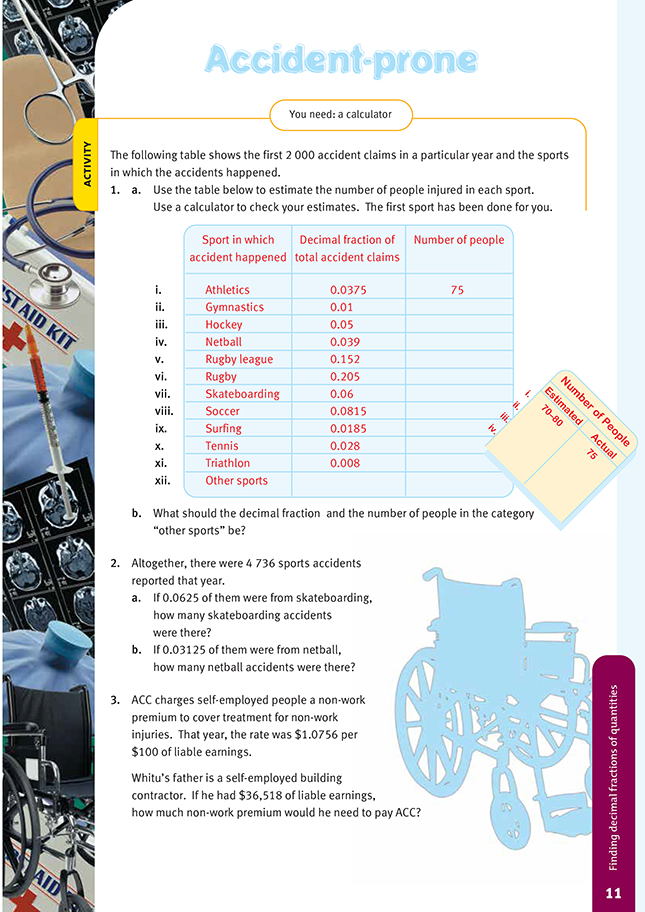This is a level 4 number activity from the Figure It Out series. It relates to Stage 7 of the Number Framework.
A PDF of the student activity is included.
Click on the image to enlarge it. Click again to close. Download PDF (201 KB)
find decimal fractions of whole numbers
FIO, Level 4+, Number, Book Six, Accident-prone, page 11
A calculator
To undertake the estimation requirement in question 1a, the students need to understand what the decimal fractions mean in terms of number per hundred. An estimate and the actual figure for athletics injuries are provided, so you could use this as a teaching example. For the decimal fraction of claims relating to athletics,
the students will need to realise that the 0.03 something means at least three per hundred.
Since there is a total of 2 000 claims, this means that there are 20 hundreds altogether so, if the figure were just 0.03, the number of people would be 60 (3 x 20).
The second kind of understanding needed is that of the magnitude of fractions. In the athletics example, the students need to realise that while the 0.03 means three per hundred, it is actually more than three but less than four (although closer to four than three). This leads to the notion of range. There are several reasons why it is more useful to be able to estimate within a range than to estimate a single number. In life,
we often estimate within a range, for example, when we say we expect to arrive in a particular place between 4 p.m. and 4.30 p.m. Estimating within a range also takes away from the students the sense of failure they tend to experience when their single estimate turns out to be “wrong”. In the athletics example, the students should be able to follow the reasoning that the number will be somewhere between 70 and 80 people.
A technical strategy that students may find helpful in using the calculator to work out the number of people involved is to put the figure of 2 000 (accident claims) into memory. Then, instead of having to key it in for each calculation, they can simply key in the decimal, then x , then RM to recall the 2 000, and press = . Alternatively, they could put 2 000 in as a constant.
In question 3, some simple explanation may be needed about what a “non-work premium” is (basically, an amount of money that is over and above what self-employed people normally pay for work-related injuries). The students also need to see that $36,518 is 365 lots of $100, or to be really accurate, it is 365.18 lots of
$100. When the students understand this, they may wonder whether they should multiply $1.0756 by 365 or 365.18. The answer is that it depends on how the issue is interpreted. This is another example of a problem that can have more than one valid solution, depending on definitions.
Answers to Activity
1. a. Estimates may vary, but they should be close to the calculated answers. The actual answers are:
i. 75
ii. 20
iii. 100
iv. 78
v. 304
vi. 410
vii. 120
viii. 163
ix. 37
x. 56
xi. 16
b. Other sports: 0.3105 of total accident claims and 621 people.
2a. 296
b. 148
3. $392.79 is based on full amount and $392.59 if based on whole $100 units.
